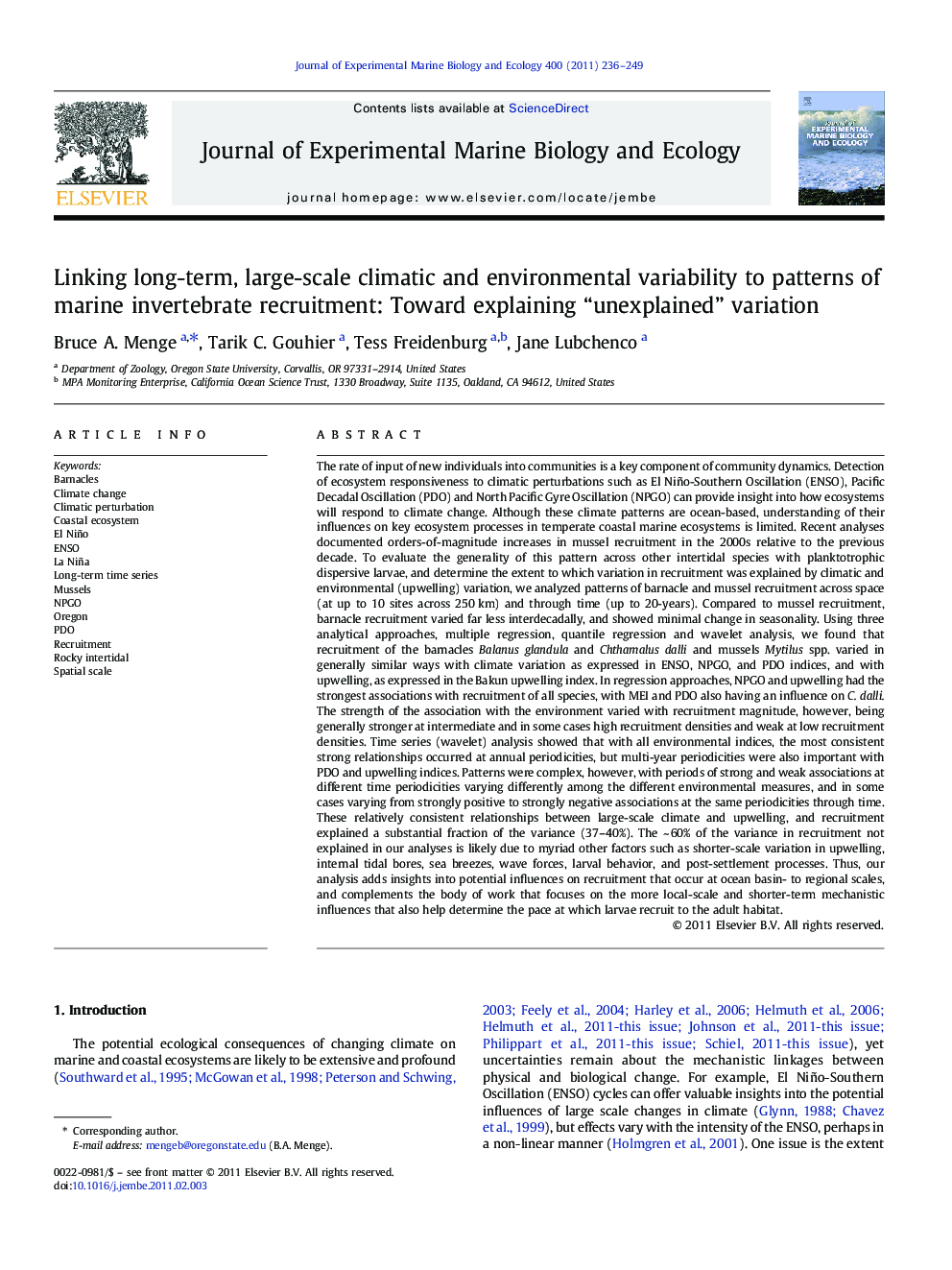| کد مقاله | کد نشریه | سال انتشار | مقاله انگلیسی | نسخه تمام متن |
|---|---|---|---|---|
| 4396352 | 1618463 | 2011 | 14 صفحه PDF | دانلود رایگان |

The rate of input of new individuals into communities is a key component of community dynamics. Detection of ecosystem responsiveness to climatic perturbations such as El Niño-Southern Oscillation (ENSO), Pacific Decadal Oscillation (PDO) and North Pacific Gyre Oscillation (NPGO) can provide insight into how ecosystems will respond to climate change. Although these climate patterns are ocean-based, understanding of their influences on key ecosystem processes in temperate coastal marine ecosystems is limited. Recent analyses documented orders-of-magnitude increases in mussel recruitment in the 2000s relative to the previous decade. To evaluate the generality of this pattern across other intertidal species with planktotrophic dispersive larvae, and determine the extent to which variation in recruitment was explained by climatic and environmental (upwelling) variation, we analyzed patterns of barnacle and mussel recruitment across space (at up to 10 sites across 250 km) and through time (up to 20-years). Compared to mussel recruitment, barnacle recruitment varied far less interdecadally, and showed minimal change in seasonality. Using three analytical approaches, multiple regression, quantile regression and wavelet analysis, we found that recruitment of the barnacles Balanus glandula and Chthamalus dalli and mussels Mytilus spp. varied in generally similar ways with climate variation as expressed in ENSO, NPGO, and PDO indices, and with upwelling, as expressed in the Bakun upwelling index. In regression approaches, NPGO and upwelling had the strongest associations with recruitment of all species, with MEI and PDO also having an influence on C. dalli. The strength of the association with the environment varied with recruitment magnitude, however, being generally stronger at intermediate and in some cases high recruitment densities and weak at low recruitment densities. Time series (wavelet) analysis showed that with all environmental indices, the most consistent strong relationships occurred at annual periodicities, but multi-year periodicities were also important with PDO and upwelling indices. Patterns were complex, however, with periods of strong and weak associations at different time periodicities varying differently among the different environmental measures, and in some cases varying from strongly positive to strongly negative associations at the same periodicities through time. These relatively consistent relationships between large-scale climate and upwelling, and recruitment explained a substantial fraction of the variance (37–40%). The ~ 60% of the variance in recruitment not explained in our analyses is likely due to myriad other factors such as shorter-scale variation in upwelling, internal tidal bores, sea breezes, wave forces, larval behavior, and post-settlement processes. Thus, our analysis adds insights into potential influences on recruitment that occur at ocean basin- to regional scales, and complements the body of work that focuses on the more local-scale and shorter-term mechanistic influences that also help determine the pace at which larvae recruit to the adult habitat.
Research Highlights
► Analysis of long-term recruitment records for sessile invertebrates showed similar relationships to ocean-basin scale climate patterns.
► Long-term patterns of barnacles at the site scale were dissimilar from those for mussels.
► Large-scale climate patterns explained up to 40% of the variance in recruitment of mussels and barnacles to rocky intertidal regions.
Journal: Journal of Experimental Marine Biology and Ecology - Volume 400, Issues 1–2, 30 April 2011, Pages 236–249